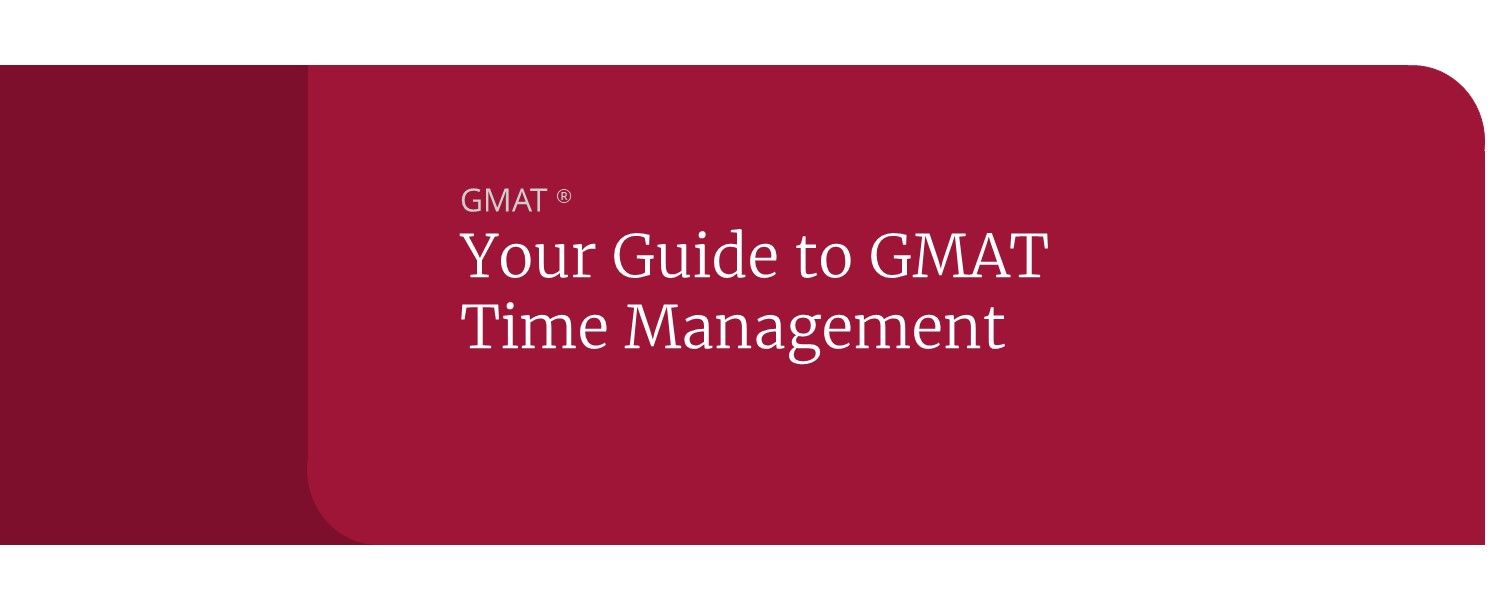Everything You Need to Know about GMAT Time Management
The GMAT is really a test of your executive reasoning skills: Your ability to evaluate a “business opportunity,” recognize which ones are good opportunities (and which aren’t), prioritize accordingly—and stick to your decisions. In other words, the GMAT is testing you on your ability to make effective business decisions. And time management is naturally a key skill in making effective business decisions.
The GMAT is sometimes going to ask you to solve problems that are actually way too hard or that will take way too long, even if you can get them right. That is, the GMAT is deliberately going to try to get you to mess up your timing. If it succeeds, your score is going to be anywhere from a little to a lot lower than it could have been.
This post will take you through how to train yourself to switch from an “old school” mindset (try to get every problem right) to a “b-school” mindset (make the best decision based on current information, including walking away from low-quality investment opportunities).
Study plan note: Bookmark this article. Take about 2 to 4 weeks to work through Step 4. Then come back to add Steps 5 through 9 to your repertoire. Don’t try to read / learn everything in one sitting! It will be too much and then you won’t remember any of it well enough.
TABLE OF CONTENTS
- How GMAT Scoring Works
- Practice Tips: Exam Mode vs. Study Mode
- Time Management Per Problem
- Practice Timing in Short Sets
- Using Benchmarks In A Test Section
- Exam Breaks
- Quant Section Time Management
- Verbal Section Time Management
- Data Insights Section Time Management
1. How GMAT Scoring Works
You don’t need to know exactly how GMAT scoring works, but you do need to learn some things in order to earn your best possible score. And the first thing to know is this: The way you were trained to take tests for your entire school career will not work on the GMAT. If you try to get everything right, as you did on school tests, you’re going to mess up your timing and lower your score.
The GMAT is an adaptive test; your tests in school were linear tests. On linear tests, everyone takes the exact same test and your score is based on how many you get right. On the GMAT (and adaptive tests in general), though, your score isn’t based on the number of problems you answer correctly. In fact, most people answer approximately the same number of problems correctly, regardless of final score!
How is that possible? On the GMAT, your score is actually based on the difficulty of the problems that you can answer correctly. If you are able to correctly answer harder questions than the person sitting next to you, you’ll earn a higher score on the GMAT. (Unless you run out of time and don’t answer all of the questions…more on this later.)
There’s another weird thing to wrap your head around. Your GMAT score is not an average of your collective performance across an entire section. Rather, think of the GMAT as a “where you end is what you get” test.
For example, let’s say that you’re halfway through the Quant section and you’re currently scoring in the 90th percentile. Great!
But then you start to run out of time. You start rushing and guessing—and making a lot more mistakes. By the last question in the section, your scoring level has dropped to 60th percentile:
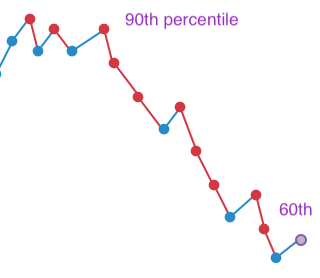
So what’s your final score? Somewhere in between, like 75th percentile? No, actually. Where you end is what you get, so your score is 60th percentile.
That may sound really unfair at first glance. But it’s a great test of your executive reasoning skills. Imagine: You’re running a division of your company and have an annual budget, but you’ve already spent the entire budget by September…and your fiscal year doesn’t end until December. It doesn’t matter that things were going really well halfway through the year if you crash and burn at the end of the year.
So How Does GMAT Scoring Work?
In any one section, your first problem will be a medium-level problem. As you answer problems correctly, the test will give you a harder mix of problems; as you answer incorrectly, the test will give you an easier mix of problems. The test is literally adapting to your skill level as you take it.
People often take this to mean that they should spend a lot more time on the harder problems—but, first, that will take extra time and, second, if you do get them right, your “reward” is even harder problems….which will take even more time…see where this is going? (This is how the GMAT deliberately tempts you to mess up your timing and then crash and burn before the test section is over.)
So you really will choose not to try to address certain too-hard problems as you go. Your goal is to earn the hardest questions that you can, and then choose to guess and move on when they do get too hard. You’re not “getting it wrong.” Rather, you’re declining to invest in a poor business opportunity.
GMAT Expert Tip: You only need to get about 50% to 70% of the problems right. You can afford to let the annoying ones go.
Next, if you miss an easier problem, that will hurt your score more than when you miss a harder one—so if you rush on easier ones to give yourself extra time for harder ones, you risk making careless mistakes on those easier ones and dropping your score.
Your score will also drop more when you miss a lot of questions in a row, with no correct answers to break up the string of wrong answers. For example, if you miss 4 questions in a row, your score will drop more than if you miss 4 out of 6 questions. Why?
The test is literally calculating your current scoring level after every problem you answer in order to decide what problem to give you next. For example, if you miss #6 through #9 straight, your score will drop each time you answer one incorrectly. The fourth-wrong-in-a-row will be an easier problem than the first one, since the test is adjusting after each wrong answer—so your score keeps dropping further every time.
Let’s say instead that you miss #6, #8, #9, and #11. Your score will still drop on those four, but your score will increase on #7 and #10—the ones you get right. Since you have some correct answers interspersed with the wrong ones, you won’t be offered as easy questions as in the first scenario, so your net drop won’t be as great. Your fourth incorrect problem in this scenario will have a higher difficulty level than the fourth wrong problem in the first scenario.
“Where you end” is literally higher in the second scenario:
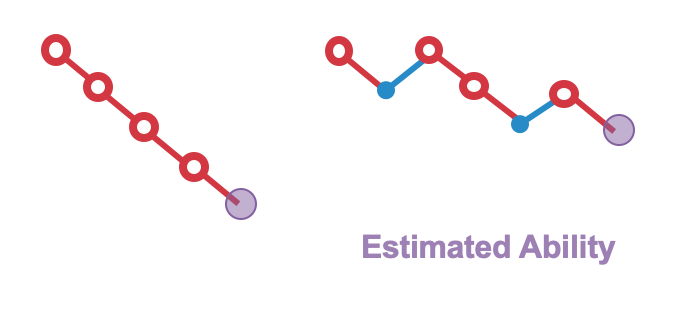
You can get away with making one or two careless mistakes on easier problems, but if you put yourself in the position of having to rush on a lot of problems, you will make too many careless mistakes on easier ones and your overall score will drop.
How Does Changing Answers on the GMAT Work?
On your first time through any test section, you have to choose an answer for each problem in order to get to the next problem and you can’t go back to the prior problems. But when you get to the end of the section, the GMAT Focus is built to allow you to fix a small number of mistakes.
When you get to the end of any section, you can review the problems in that section and change up to 3 answers (assuming you haven’t run out of time). If you suddenly remember a formula or rule that you’d forgotten earlier, or if you suspect that you might have messed up your analysis on a specific problem, you have the opportunity to go back and pick up those points.
One more thing: If you run out of time and don’t submit an answer at all for certain problems, there is a penalty. And the more problems you don’t answer, the greater the penalty. In other words, if you are approaching the end of the section and running low on time, don’t leave anything blank. Even if you have to guess randomly, put in an answer for every single problem.
>> Put Your Quant and Verbal Skills To The Test With A Free 11-Question GMAT Quiz
2. Tips For Solving Official Guide or Other GMAT-format Practice Problems
Early in your GMAT prep, you’re going to start solving individual Official Guide or other GMAT-format problems. There are two principles to use: Exam Mode (for the first time you try a GMAT-format problem) and Study Mode (for everything you do after you’ve tried that problem for the first time).
GMAT Timing Tip 1: Start Practicing Your Timing Now (Exam Mode)
The first time you do an official-format GMAT practice problem, do so in Exam Mode: Pretend you’re taking the test. Do not take 10 minutes because “I just want to see whether I can figure it out.” Whatever habits you build during practice, you’re going to use those same habits on the real test—and you definitely don’t want to spend 10 minutes on a single problem during the real test! Instead, make the call you’d want to make if you really were taking the real exam right now.
Note: When you are doing non-GMAT-format practice, such as skill drill sets, don’t time yourself. Learn at a pace that works for you. Only time yourself when working on Official Guide or other official-GMAT-format problems.
GMAT Timing Tip 2: Take As Much Time As Needed To Learn New Material (Study Mode)
After you’ve tried the problem in timed Exam Mode—and chosen an answer—now switch to “Can I figure it out?” mode (aka Study Mode).
Don’t look at the answer or explanation (yet). Try any other possible solution paths you can think of. Look up anything you want in your books. (Study mode is always open-book mode.) If you tried a similar problem recently, look at that one again to see whether it gives you ideas for this new one.
When you do go to the explanation, don’t read it straight through. Rather, use the explanation as a series of hints—like your own personal tutor. Read just far enough until you get an idea. Then, stop reading the explanation and use that idea to see how much you can figure out on your own (and you can use your books and other resources). When you get stuck, go back to the explanation for another hint.
Why study this way? It seems like it’ll take a long time.
It’s true that it’ll take longer than just reading the explanation…but you’ll actually remember what you’re studying. How many times have you read straight through an explanation, thought “That makes sense,” and then realized a week later that you have no idea how to do that problem? Your goal is to learn how to do this yourself in future, not just to read something and think “That makes sense.”
Here’s your mantra:
- Exam Mode: First time you try a GMAT-format problem. Time yourself. Choose an answer before you go to the next problem. Train yourself to make the same decisions you’d want to make if today were test day.
- Study Mode: Review and figure out as much as you can yourself. Take as long as you need and use any study resources you want.
>> Identify Strengths and Weaknesses Early With a Free GMAT Starter Kit
3. How Much Time To Dedicate For Each GMAT Problem
In order to make good executive decisions about what to do as you progress through each individual problem, you’ll need an approximate idea of how long you’re spending on those individual problems.
Before we dive in: Some people are granted extended time on standardized tests. If this applies to you, please adjust all timing guidelines in this document according to the extended time that you were granted. (For example, for 50% extended time, multiply all timing guidelines by 1.5. For 100% extended time, multiply all guidelines by 2.)
On most GMAT problems, you’re going to make an important decision within about 1 minute of starting the problem. (Alternatively: 1.5 minutes for those granted 1.5x time, or 2 minutes for those granted 2x time.)
Why 1 Minute When Most Problems Take Longer?
The 1-minute mark represents roughly the halfway point for most problems. Halfway through any kind of project is a great “take stock and make decisions” moment.
At the 1-minute mark, you’ve gathered enough information to know whether you (1) understand and (2) have an idea about how to solve. And on some, you’ll have already started solving.
If you’ve spent half your time and don’t understand or don’t have an idea for how to solve, then your odds of figuring that all out and solving in the second minute are really not good. The best executive decision is to guess and move on. Bonus: You’ve just saved yourself a minute—and some mental energy—to use on a better problem elsewhere.
If you actually have a chance to solve this problem correctly, then by the 1-minute mark, here’s where you want to be:
| Question type | average time | 1-minute goal (by 1 min, i have gotten at least this far |
|---|---|---|
| Reading Time: | ||
| – Multi-Source Reasoning – Reading Comprehension | 1.5 to 2 minutes | – Understand passage / tabs – Create a short map / cheat sheet |
| Answering problems: | ||
| – Two-Part | 2.5 minutes | – Understand facts given and question asked – Have a plan to solve |
| – Problem Solving – Data Sufficiency – Tables and Graphs – Critical Reasoning – Multi-Source Reasoning | 2 minutes | – Understand facts given and question asked – Have a plan to solve |
| – Reading Comprehension | 1.5 minutes | – Understand question – Reread / understand relevant info in passage / tabs |
One important note: The expected average times are truly averages. It’s perfectly fine to spend some extra time on certain problems, because you will also finish other problems in less than the average time.
In general, avoid going more than 1 minute beyond any question-type average. If you need that much extra time, something’s going wrong on this problem; your odds of getting it right have already gone way down. It’s better to move on at that point.
| question type | average time | avoid going beyond |
|---|---|---|
| – RC/MSR reading time | Shorter: 1.5 minutes Longer: 2 minutes | ~2.5 minutes |
| – Two-Part | 2.5 minutes | ~3.5 minutes |
| – PS – DS, Table, Graph, MSR – CR | 2 minutes | ~3 minutes |
| – RC questions | 1.5 minutes | ~2.5 minutes |
If you have been granted extended time, still hold to the “don’t go more than 1 minute beyond your expected average” guideline. For example, for 1.5x time, the expected average time for a PS problem is 3 minutes. Don’t spend more than about 4 minutes on any one PS problem. For 2x time, the expected average time for a PS problem is 4 minutes. Don’t spend more than about 5 minutes on any one PS problem. This is the only time that we’re going to tell you not to adjust a timing measurement for your extended timing rules.
How Do You Know It’s Been a Minute?
You’re going to develop your 1-minute time sense. (Or your 1.5 minute sense or your 2 minute sense, if you have been granted extended time.)
Open up the stopwatch on your tablet or phone. Look for the Start and Lap buttons (the start button may turn into the lap button after you start the stopwatch). And put your brain in Exam Mode.
After you start the timer, try tapping the lap button to see what happens. The timer will mark the time at which you tapped Lap and the timer will keep running. As you keep tapping the Lap button, you get a list of time intervals, each measuring from the last time you tapped Lap.
Find a non-GMAT-related task that takes concentration, for instance:
- Read an article
- Write an email
- Research a business school
Use some paper to cover up your device’s display so that you can see only the Lap button. Start concentrating on your task. Every time you think about a minute has passed, tap the Lap button. Keep working and tapping Lap whenever you think another minute has gone by. A little while later, pause and look at the list of Lap numbers.
If most of your lap times are within about 20 seconds of 1 minute (that is, between 40 seconds and 1 minute 20 seconds), great! Try this a few more times over the next few days; if your results continue to be consistent, you’re good to go.
If you’re like most people, though, you won’t already have a good 1-minute time sense—most people are all over the map when they first start this. Keep doing this exercise a few times a day for 5 to 10 minutes at a time. After a couple of weeks, you’ll get yourself more consistently into a “close enough” time range (00:40 to 01:20). You don’t have to be in the range every single time; most of the time is good enough.
Some people are consistently fast or consistently slow. For example, you may find that your times are all around 30 to 50 seconds—that is, you’re consistent but too fast. You need to retrain your brain to wait a little longer. Try tapping the button when your brain thinks it’s been 1 minute 15 seconds.
Alternatively, you might find that your timing is consistently too slow—you think it’s been a minute but it’s really been more like 1:20 to 1:40. In this case, try to tap the button when you feel like it’s been only 45 seconds. You’re retraining your brain to jump in a little faster.
Ok, It’s Been a Minute…and I Don’t Understand This Problem. Now what?
If you are 1 minute into a question and you don’t understand or don’t have a good idea of how to solve, switch gears. Trying to solve for the right answer isn’t working. Is there anything you can do to eliminate wrong answers?
If you don’t see a path for that either, then the best decision is to save any remaining time to use on a different problem. In this case, guess and move on.
And congratulations—you’ve just earned a double benefit. You’ve also prevented yourself from getting sucked into an annoying problem and losing a bunch of time and mental energy that you would have been better off spending somewhere else in this section.
4. How To Practice GMAT Question Timing in Short Sets
After you’ve developed your 1-minute sense, your next step is to learn to balance a block of time among a small set of questions.
How Do I Balance My Time on Problem Sets?
First, you’ll need two timers—one with a lap button and one that simply counts down from your overall time limit (here’s the Google timer for the second one). And again put yourself in Exam Mode mindset.
You’re going to do Quant problems in sets of 4 (we’ll explain why a little later in this article). Problem Solving (PS) problems average 2 minutes each, so set your overall timer to 8 minutes.
Next, choose 4 Problem Solving problems, cover up the time on your lap timer, start both timers, and dive in. When you think it’s been roughly a minute since you began the first problem, tap the lap button.
And, as you tap, ask yourself:
- Do I understand what the problem is telling me and what is asking me to do?
- Do I have a decent idea of what to do to get to the answer?
If not, pick an answer (any answer!), tap the lap button again, and move on to the next problem.
If you do say yes to those two questions, keep trying to solve this problem. Tap the lap button a second time when you’ve finished it and chosen your answer.
What if you’re done with the problem and you don’t think it’s even been 1 minute yet? Check your work for careless mistakes. You might be fine! But if it was really that easy, it won’t take long to check your work.
Repeat this process until you’ve finished all of the problems in the set, hitting the lap button one minute into the problem (and making a call about whether to keep going) and again when you’ve chosen your answer. Then, analyze your data. You’ll hopefully have 8 lap times. (You might forget to hit the lap button every time at first. You’ll get better with practice.)
Assuming you do have 8 lap times:
- The odd-numbered data points (1, 3, 5, and 7) represent your first approximately 1 minute for each problem. Your goal is to have these times be roughly within the 0:40 to 1:20 timeframe.
- The even-numbered data points (2, 4, 6, and 8) represent the remaining time you spent on the second half of each problem. These might range from a few seconds to 2 or more minutes:
- If you found the problem easy or decided to guess quickly and move on, you might have only 10 to 30 seconds for the “second half” time.
- On a harder one, you might have decided to invest some extra time, so this data point might be more like 1:30 or 1:45. That’s fine.
- If you spent 2+ minutes in the second half, though, then analyze how to improve next time. Is there a way to do the problem more efficiently? Alternatively, should you have cut yourself off, guessed, and moved on? At which specific point should you have made that call?
How Do I Analyze My Time Management for Problem Sets?
This particular problem set (4 PS problems) had a total expected time of 8 minutes.
First, how much time did you take collectively for the entire set?
- If you had four answers by the time your countdown timer dinged, great! (Assuming you didn’t make any careless mistakes due to rushing.)
- If not, then on the real test, you just ran out of time with problems left unanswered. (The good news: You’re about to learn how to get better next time.)
Look at the individual problems.
- Where did you make good timing decisions?
- Where did you spend too much or too little time?
- What decisions would you want to make differently next time to avoid rushing or running out of time?
- What specific clues will prompt you to know to make that decision? (One of mine: If I find myself thinking, “But I should know how to do this…” then I know I need to guess and move on. I should know is just a clue that I’m stuck.)
Next time you do a timed set, reinforce the Exam Mode mindset. You will need to cut yourself off sometimes. Other problems are still coming—ones that might be easier than your current problem. Don’t leave those future problems on the table because you’re stubbornly hanging onto the annoying problem in front of you right now.
Sometimes, you’ll realize that there was a valid way to narrow down the answer choices—that is, to cross off wrong answers even though you didn’t know how to get to the correct answer.
Take some time to think that through now, as well as how you’ll recognize when you can use that same analysis on future problems. You do have to guess a lot on the GMAT; educated guessing is a fantastic way to improve your odds.
Repeat the Process
Take about 2 to 4 weeks total to practice your 1-minute time sense on single problems and then on short sets of problems.
Guidelines for building short timed sets:
| gmat section | # of problems | average time per problem | total time for set |
|---|---|---|---|
| Quant | 4 | 2 minutes | 8 minutes |
| Data Insights* | 4 | 2.25 minutes | 9 minutes |
| Verbal | 6 | 1.8 minutes | 12 minutes |
*For Data Insights, have a maximum of either one Two-Part or one MSR prompt in a short set. You can have any number of the other DI problem types.
After you start feeling okay with your time management for short sets, expand your time management skills to cover an entire section of the GMAT.
5. Using Benchmarks To Manage GMAT Section Timing
Reminder: Spend several weeks practicing what’s described in sections 1 through 4 of this post before you add in the next set of skills.
For each section of the GMAT, you’ll have a block of time to answer all of the problems. You can choose how to allocate that time, but you’ll still need to hit the per-question average in order to finish on time.
Here are the overall details for each section:
| GMAT Section | Time | Number of Problems | Average Time Per Problem |
|---|---|---|---|
| Quantitative | 45 minutes | 21 | 2.15 minutes |
| Data Insights | 45 minutes | 20 | 2.25 minutes |
| Verbal | 45 minutes | 23 | 1.8 minutes |
In practice, you’re going to spend somewhere between 1 minute and 3 minutes on most problems.
Occasionally, you won’t spend more than 30 seconds on a problem. When you see a problem that’s a significant weakness of yours or just looks absolutely awful, guess fast—basically, as soon as you recognize that this problem is Terrible. Aim to do this on 1 to 3 problems in each section (Quant, DI, and Verbal).
GMAT Expert Tip: Prepare a list of what you always get wrong or take too much time to do so that you can make a quick executive-reasoning call to bail early and move on. Use that saved time and mental energy elsewhere!
To use benchmarks to track your timing, we’re going to split each section of the test into “blocks” of questions:
- Quant: 4 questions per block
- DI: 4 questions per block
- Verbal: 6 questions per block
You’ll use your scratch paper to keep track of these timing blocks (the rest of this article will show you how). In the testing center, you’ll get a bound booklet of 5 sheets of laminated, legal-sized paper. For practice at home, consider using a GMAT test simulation booklet. (If you’re taking our course and chose physical books, you received a test simulation booklet in your book package.)
If you take the GMAT Online, you’ll buy your own erasable whiteboard and you’ll also have access to an online whiteboard during the test. Sections 7 through 9 of this post illustrate how to set up your time tracking strategy for both the testing center and online versions of the exam. You’ll use the exact same time management strategy in either scenario; the way you write it down will just be a little different, depending on the exam format you choose.
6. GMAT Exam Break
You will have one 10-minute break on the GMAT Focus that you can use between any two sections of your choice—and you can take the test sections in whatever order you choose. We recommend planning to do your Verbal section and one other section without a break in between.
If you want to do Verbal in the middle, take your break either before or after Verbal, as you choose:

We don’t recommend combining Quant and Data Insights in the same “chunk” and then doing Verbal by itself. Quant and Data Insights have a lot of overlap and your brain will benefit from having a break between them.

Your test order choice also feeds into your Yellow Pad strategy in the testing center. You can raise your hand during any test section to switch out your used Yellow Pad for a fresh pad, but it’s a lot less disruptive to switch out your Yellow Pad just once, during your one break.
You’ll need 4 faces of a page (out of 9 provided in the Yellow Pad) to do Verbal and 5 faces each for Quant and DI. So you can use one Yellow Pad for Verbal plus whichever other section you choose to do in the same chunk with verbal, and then use a second Yellow Pad for the section you do by itself.
During your GMAT exam, you are not allowed to set up anything on your scratch pad during the break. If you’re in a testing center, you are also not allowed to sit in the testing room during your break.
You will have a 30-second introduction screen right before each section starts. Use this time to take a deep breath and set up your time management strategy on your scratch pad for the next section.
7. Time Management For The Quant Section
ALERT: Please spend several weeks getting comfortable with sections 1 through 6 of this post before starting on sections 7 through 9. (There’s a lot of information in this post; there’s a serious risk of getting it all jumbled up in your memory if you try to learn it all at once.)
You can use the same time management strategy whether you take the test in a testing center or online, but your scratch paper is different for the two exams, so the way you write this out will be a little different. We’ll go through the testing center Yellow Pad method first and then the GMAT Online method.
You’ll break the Quant section into blocks of 4 questions. But there are 21 questions in this section, so you’ll have to have one block of 5 problems.
You’ll need 5 of the 9 sheets or faces in a Yellow Pad booklet for the Quant section. If your booklet is still clean, start on the very first blank face. If you’ve already done the Verbal section, flip to the first clean face after your Verbal notes.
Actually practice all of the below before you try your first practice test. It’s not as easy as it might look—but once you practice it a few times, you’ll know exactly what to do.
On the very first clean face:
- Draw one horizontal line fairly close to the top (as shown in the diagram), then draw a big “plus” sign below it to divide the remainder of the page into four equal segments. You’ll do 5 problems on this page, one above the line and the other four in the four quadrants of the plus sign.
- Write 34 in the bottom right corner of the page.
How To Set Up The Yellow Pad For GMAT Quant
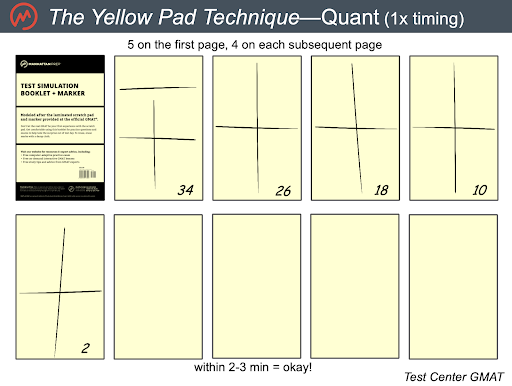
On the next 4 faces, draw just the big plus-sign, as you’ll only do 4 problems per page after the first one. Continue counting down the time by 8-minute increments: 34, 26, 18, 10, and finally 2 on the very last page.
As you tackle problems, work through the grid in order. If you decide to bail / guess quickly on a problem, put an X in that problem’s scratch space, then move to the next space to do the next problem.
When you’re done with the first block of 5 problems, your goal is to have approximately 34 minutes left on the clock, give or take a couple of minutes. When you’re done with the next block of 4 problems, the goal is to have approximately 26 minutes left, give or take a couple of minutes. And so on.
This strategy deliberately aims to leave you with 2 minutes on the clock at the end of the section. If you do get too far behind at any point, you’ve got a little buffer time already built in and you can still finish the section on time. And if you do still have that 2 minutes left at the end, you can go back to take a look at a problem that you might have bookmarked for review.
How Much Time Should I Leave For Changing Answers at the End?
While the GMAT Focus does allow you to change up to 3 answers at the end of each section, we actually don’t recommend planning to change answers. There are a few circumstances in which it’s great to have that safety net, but the goal is to be able to avoid using it at all.
Standardized tests are high-pressure situations. When the clock is ticking out its last few minutes, you’re going to be really tempted to start second-guessing yourself and you might start panic-changing answers. When that happens, you’re actually more likely to change from right to wrong than from wrong to right. So resolve right now: No panic-changing of answers.
Here are some good reasons to change an answer:
- You forgot a rule or formula the first time you saw this problem, but you’ve since remembered it.
- You realize—only after you submit an answer—that you made a careless mistake.
- You know exactly how to do the problem, but you also know it’s likely to take you 3+ minutes. Guess randomly the first time and save it for the end, if you have time. (If you run out of time, oh well. At least you didn’t waste 3+ minutes on a single problem!)
What If I Get More Than 3 Minutes Behind During the Section?
Let’s say you’ve answered 3 blocks of questions and the bottom of the current page says 18 but your timer says you actually have only 14 minutes left. So you’re 4 minutes behind. Now what?
During the next set of 4 problems, as soon as you see a problem that makes you think “Ugh,” bail—guess and move on immediately. The problem could be testing something you don’t like, or the first sentence or two is really hard to follow, or it has an ugly equation, or whatever—just choose your favorite letter and move on.
This will get your timing back on track. As long as you’re diligent about making yourself do this as soon as you realize that you’re more than 3 minutes behind, the time deficit won’t build up to the end of the section and cause you to run out of time when you still have a lot of problems to answer.
What If I Get More Than 3 Minutes Ahead During the Section?
Let’s say that the bottom of your current page says 18 but the timer says 23 minutes left, so you’re 5 minutes ahead.
Start by taking a deep breath. Rushing can cause careless mistakes. It might be ok that you’re this far ahead, but just check that you’re working methodically to minimize careless mistakes. If it’s math, write it all down—don’t do it in your head. Make yourself check for the proof in the RC passage or MSR tabs—don’t just rely on memory. Basically, don’t cut corners while solving.
The first time you take a practice test using the Yellow Pad Technique, you’re probably going to screw up your timing at least a little. You might screw it up a lot. That’s okay—that’s what practice is for. By the time you get to the real thing, you’ll be able to set up your timing grids in 30 seconds and you’ll know how to react appropriately (and immediately!) when you realize that you’re too far behind or ahead on your time.
How To Set Up Quant Time Management for GMAT Online
The overall time management strategy is the same, but your scratch paper is different for the GMAT Online. You’ll use a dry erase whiteboard to do your work, but this whiteboard won’t have a lot of space (maximum 12 by 20 inches or 30 by 50 centimeters). Instead, use the online whiteboard tool to keep track of your time for the GMAT Online, while doing the scratch work itself on your physical whiteboard.
Here’s a tutorial on how the online whiteboard tools work.
When the test section begins, pull up the online whiteboard. Resize it to make it small enough to fit into just a corner of the screen. Grab the pen or line tool and recreate the same lines that were shown above for the Yellow Pad, like this:
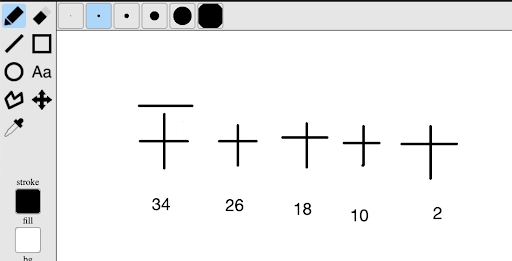
Draw five plus signs. Put an extra horizontal line above the very first plus sign. Below the plus signs, type or write out the Quant time markers: 34, 26, 18, 10, 2. Don’t worry about placing things perfectly—everything just needs to be spaced far enough apart to be clear.
Next, as you work your way through the test, make a check mark whenever you click to Submit a problem, like this:
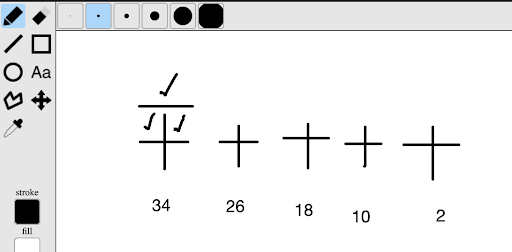
Make this step part of your routine. Every time you hit the button to submit your current problem and go to the next one, you have this one extra step: Check off that problem on your grid. (Do this even if you guess randomly on a problem and move on right away.)
If you ever forget to make the mark, glance at the top right of your screen to see the problem number that you’re on right now. For example, let’s say that the screen says you’re currently on problem 4. You’re not done with this current problem yet, so you should have 3 check marks. And there are 3 check marks, so all is good.
But what if the screen says problem 5 and you only have 3 check marks? You’ve done 4 by now, so just add another check mark to make your grid have the right count.
Every time you fill up a plus sign grid, glance at your timer and compare it to the time written below that grid. Follow the same guidelines as given for the Yellow Pad method above—if you’re within a few minutes, carry on. If you’re too far ahead or behind, take steps accordingly, as discussed earlier.
8. Time Management For The Verbal Section
(Note: Read the Quant Time Management section first before reading this section.)
In Verbal, you’ll periodically have to take some extra time to read Reading Comprehension passages before you can answer the questions. There are typically either 3 or 4 RC passages in the Verbal section, so we’re going to split the 23 Verbal problems into 4 blocks, or approximately one block per RC passage.
Of course, 23 doesn’t divide evenly into 4, so you’re going to do 5 problems in the first block and then 6 problems in each block after that. (This is sort of similar to Quant: In Quant, you’ll do 5 problems in the first block and then 4 problems in each block after that.)
Use any four consecutive pages, either at the beginning of the booklet or the end. Place your time markers in the lower right corner again, but this time you aren’t going to draw the little plus signs.
Instead, draw a horizontal line about ¼ to ⅓ of the way down each page. Above the line, keep track of your answer choice decisions for each of the problems in that block. (If you make a guess, still jot down whatever random answer you’re going to pick.) Use the area below the line for any notes or scratch work as needed.
How To Set Up The Yellow Pad For GMAT Verbal
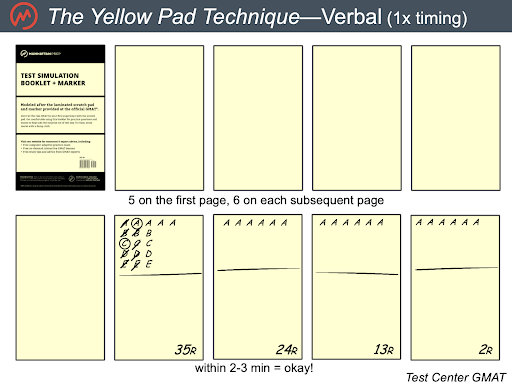
If you tend to have timing issues on Verbal, also add the letter R next to each timing number, as shown in the graphic. That R is to help keep track of your Reading Comprehension passages. You’ll spend about 1.5 to 2 minutes reading the passage before you can begin to answer the problems. Usually, you’ll get 3 or 4 RC passages on the GMAT and the odds are good that you will start one new passage in each of the 4 blocks.
That is, you will most likely start your first RC passage somewhere during the first block. You’ll probably start your second RC passage somewhere in the next block. And so on. (It is possible that the passages could be more clumped together. Read on to learn how to account for that possibility.)
The most common scenario is shown in the top right of the graphic below: You get exactly one RC passage in this block. When the passage first pops up, cross off the R. When you get to the end of this block of problems, you should have approximately 24 minutes left on the clock (give or take a few minutes). If you’re more than a few minutes ahead or behind, take action.
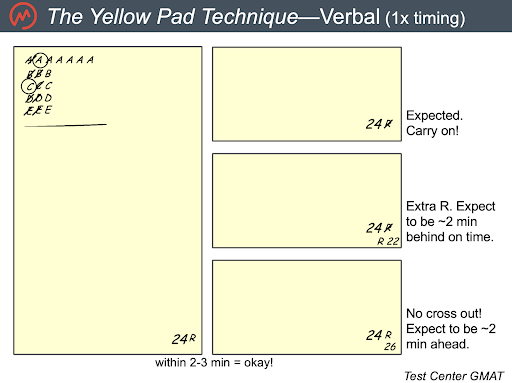
What if you’ve already crossed off your R, and they give you a second RC passage in that same block? Use the method shown in the second box on the right side of the graphic above: Jot down another R but don’t cross it off. That’s your signal that you got an extra RC passage in this block, so you’re going to be a bit short on time compared to the 24 minutes written on the page.
Expect to be about 2 minutes slow—so if, for example, the time marker says 24, subtract 2. You’re now aiming to have around 24 – 2 = 22 minutes left at the end of this block. If you find yourself more than a few minutes ahead or behind 22 minutes, take action.
The final possibility is shown in the third box of the graphic: You get all the way through a block without starting an RC passage, so you haven’t crossed off the R. When this happens, expect to be a couple of minutes ahead of your expected time at the end of that block. In the example above, expect to be at about 24 + 2 = 26 minutes by the end of that block; if you’re more than a few minutes ahead or behind the 26-minute time, take action.
If you find that your timing is ok on Verbal, you can drop the R method to keep track of your RC passages and just use the overall blocks of 6 to keep yourself on track.
Do I Really Have To Write Out ABCDE 23 Times for the Verbal Section?
No, there is a more streamlined way, if you prefer. Our example images show ABCDE written out for the first few problems. But that’s a lot of work to do for the whole section. Ideally, practice writing out 6 As but then only write out the rest of the letters once for the first problem in each block, then track your work for each problem in the blank space below the relevant A and to the right of the B, C, D, and E letters in the very first column.
Put enough vertical space between each letter that you won’t mix them up. Still use your usual symbols to eliminate letters or circle the answer you want to choose—just do so in the blank space below each A and to the right of B through E.
GMAT Expert Tip: Once you know what answer you want to pick, jot down that specific letter and circle it—just to reinforce what you’re about to pick on screen.
You will absolutely need to practice this process, even during problem sets, to get good at it. Do all your quant problem sets in multiples of 4 from now on (4, 8, or 12) and make your verbal problem sets in batches of 6 (either 3 CR and 3 RC or 2 CR and 4 RC).
When you’re done with a full-length exam or a problem set, analyze your timing on both a global and a per-problem basis.
- Where are you happy with your decisions?
- Where would a different decision have been better?
- What clues would you have needed to spot in order to know to make that different decision?
This level of analysis will retrain your brain for next time, so that you can make your executive reasoning skills really work for you on this exam.
How To Set Up Verbal Time Management for GMAT Online
The overall time management strategy is the same for the GMAT Online, but you’ll again use your online whiteboard to keep track. This time, pull up the online whiteboard and grab the text tool, then type a series of A’s clustered together and write the time markers underneath, like this:

ype 5 As for the first cluster and 6 As for each of the remaining three clusters. Again, don’t worry about lining everything up perfectly.
As you submit each problem, cross off one letter A every time you submit an answer. As with the Quant, make it a ritual to Submit a problem and immediately cross off a letter, every single time.

If you accidentally forget to cross one off, you can check the problem count in the upper right corner of the screen to get yourself back on track. As you finish each grouping, check the timer, taking into account whether the R (for RC) is crossed off, as described earlier for the Yellow Pad Verbal strategy. (And you can drop the R part of this time tracking if you generally don’t struggle with timing on Verbal.) You’re still following the exact same strategy—you’re just keeping track slightly differently.
9. Time Management For the Data Insights Section
(Note: Read the Quant Time Management section first before reading this section.)
Data Insights (DI) is the trickiest section to manage because there are 5 different question types. In addition, Two-Part questions tend to take a bit longer, and Multi-Source Reasoning (MSR) questions are like RC—you have to read some text / prompts first before you can start answering the questions. Unlike RC, though, there’s typically only one MSR prompt in the whole section (though it is possible to see two).
The silver lining: DI has an even 20 questions in the section, so you’ll do these in 5 blocks of exactly 4 questions each. No need to remember that there’s one more or one fewer question in the first block, as is the case for Quant and Verbal.
How To Set Up The Yellow Pad For GMAT Data Insights
You’ll actually use the exact same timing guidelines as for the Quant section (34, 26, 18, 10, and 2) but you won’t need that extra problem on the first page—so just put a simple plus sign on all 5 pages. Also, add an M for MSR, similar to the R for RC:
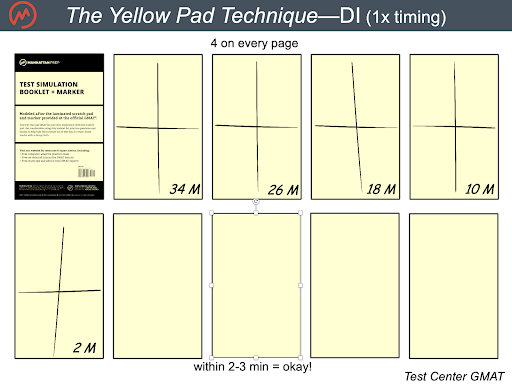
Whenever your MSR prompt first pops up, cross off the M and expect to be a couple of minutes behind at the end of that page. You’ll make up the time over the next couple of sections.
If you’re getting later in the section and have never crossed off an M, you’ll know that you need to keep an extra couple of minutes on the clock to deal with that MSR when it finally does appear.
Most people will see one MSR prompt (with several associated questions) on the test, but it is possible to get a second MSR. If this happens to you, you’re already covered: You’ve still got the 2 minutes of buffer time that you’re saving for the end of the section.
As with the quant section, if you guess quickly on a problem, put an X in that problem’s quadrant and move to the next quadrant in the grid to do your work for the next problem.
How To Set Up Data Insights Time Management for GMAT Online
As with the other two sections, use the exact same time management strategy when taking the GMAT Online, but keep track using your online whiteboard rather than the Yellow Pad.
This will look almost identical to the Quant version, except that all five will be simple plus signs and you’ll add M’s after every number:

As usual, every time you submit a problem, put a check mark in the relevant box. Cross off the M when you first see your MSR prompt. Each time you finish a grid, check the test screen clock against the expected time, adjusting downward a bit if you were given your MSR prompt within that block.
And, as usual, take action immediately, in the next block, whenever you see that you are more than a couple of minutes behind or ahead.
Okay, you know everything you need to know about time management on the GMAT Focus. Time to start practicing—good luck and happy studying!

